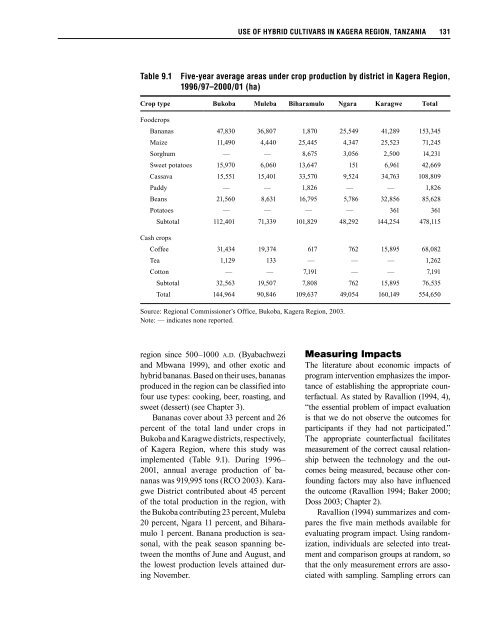An Economic Assessment of Banana Genetic Improvement and ...
An Economic Assessment of Banana Genetic Improvement and ...
An Economic Assessment of Banana Genetic Improvement and ...
Create successful ePaper yourself
Turn your PDF publications into a flip-book with our unique Google optimized e-Paper software.
USE OF HYBRID CULTIVARS IN KAGERA REGION, TANZANIA 131<br />
Table 9.1 Five-year average areas under crop production by district in Kagera Region,<br />
1996/97–2000/01 (ha)<br />
Crop type Bukoba Muleba Biharamulo Ngara Karagwe Total<br />
Foodcrops<br />
<strong>Banana</strong>s 47,830 36,807 1,870 25,549 41,289 153,345<br />
Maize 11,490 4,440 25,445 4,347 25,523 71,245<br />
Sorghum — — 8,675 3,056 2,500 14,231<br />
Sweet potatoes 15,970 6,060 13,647 151 6,961 42,669<br />
Cassava 15,551 15,401 33,570 9,524 34,763 108,809<br />
Paddy — — 1,826 — — 1,826<br />
Beans 21,560 8,631 16,795 5,786 32,856 85,628<br />
Potatoes — — — — 361 361<br />
Subtotal 112,401 71,339 101,829 48,292 144,254 478,115<br />
Cash crops<br />
C<strong>of</strong>fee 31,434 19,374 617 762 15,895 68,082<br />
Tea 1,129 133 — — — 1,262<br />
Cotton — — 7,191 — — 7,191<br />
Subtotal 32,563 19,507 7,808 762 15,895 76,535<br />
Total 144,964 90,846 109,637 49,054 160,149 554,650<br />
Source: Regional Commissioner’s Office, Bukoba, Kagera Region, 2003.<br />
Note: — indicates none reported.<br />
region since 500–1000 A.D. (Byabachwezi<br />
<strong>and</strong> Mbwana 1999), <strong>and</strong> other exotic <strong>and</strong><br />
hybrid bananas. Based on their uses, bananas<br />
produced in the region can be classified into<br />
four use types: cooking, beer, roasting, <strong>and</strong><br />
sweet (dessert) (see Chapter 3).<br />
<strong>Banana</strong>s cover about 33 percent <strong>and</strong> 26<br />
percent <strong>of</strong> the total l<strong>and</strong> under crops in<br />
Bukoba <strong>and</strong> Karagwe districts, respective ly,<br />
<strong>of</strong> Kagera Region, where this study was<br />
implemented (Table 9.1). During 1996–<br />
2001, annual average production <strong>of</strong> bananas<br />
was 919,995 tons (RCO 2003). Karagwe<br />
District contributed about 45 percent<br />
<strong>of</strong> the total production in the region, with<br />
the Bukoba contributing 23 percent, Muleba<br />
20 percent, Ngara 11 percent, <strong>and</strong> Biharamulo<br />
1 percent. <strong>Banana</strong> production is seasonal,<br />
with the peak season spanning between<br />
the months <strong>of</strong> June <strong>and</strong> August, <strong>and</strong><br />
the lowest production levels attained during<br />
November. here> 1near 9.
















